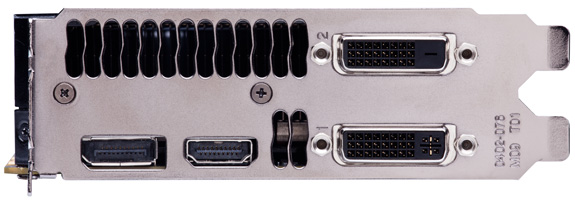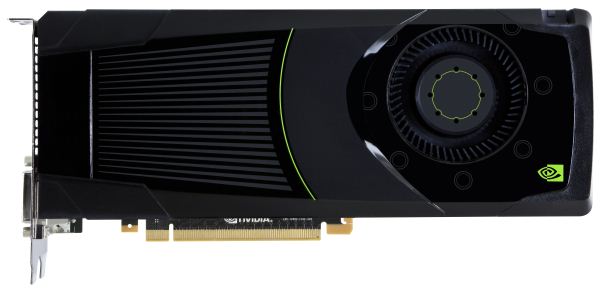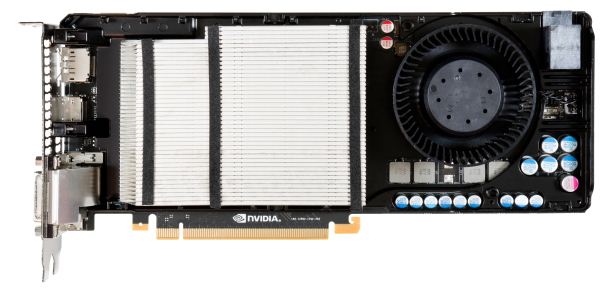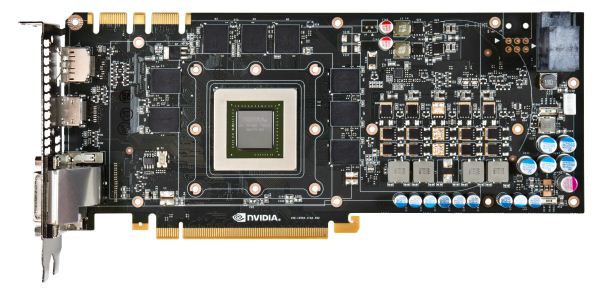NVIDIA GeForce GTX 680 Review: Retaking The Performance Crown
by Ryan Smith on March 22, 2012 9:00 AM ESTMeet the GeForce GTX 680
All things considered the design of the GeForce GTX 680 is not a radical departure from the GTX 580, but at the same time it also has some distinct differences owing to the fact that its TDP is some 50W lower than GTX 580.
Like the past GTX x80 cards, the basic design of the GTX 680 is that of a blower. A radial fan at the rear of the card sucks in air and pushes it towards the front of the card. Notably, due to a combination of card length and the fan position, the “wedge” around the fan has been done away with. NVIDIA tells us that this shouldn’t significantly impact the cooling of the card, particularly since it has a lower TDP in the first place, but when used in SLI it will remove some of the breathing room than the GTX 580 enjoyed.
Looking at the fan itself, compared to the GTX 580 the fan has been moved from the center of the card to the top of the card. This is due to NVIDIA’s port configuration, which uses a stacked DVI connector that consumes what would have normally been part of the exhaust vent on the GTX 580. We’ll get into the port configuration more in a minute, but for the moment the significance is that because the GTX 680 only has half a vent NVIDIA has moved the fan to match the vent, which is why the fan has been moved up.
On that note, the repositioning of the fan also had its own ramifications. Because the fan is now so close to the top and at the same time so close to the rear, NVIDIA went with a unique method of arranging the PCIe power sockets. Rather than having them side-by-side as we’ve seen on countless NVIDIA cards in the past, the sockets are stacked on each other in a staggered configuration. With the fan otherwise occupying the space that one of the sockets would take up, this configuration allowed NVIDIA to have two sockets without lengthening the card just to fit another socket. Overall this staggered design is not too difficult to work with, though with one socket facing the opposite way it might require some cable repositioning if you have a well maintained cable run.
Moving on, when we remove the shroud on the GTX 680 we see the fan, baseplate, and heatsink in full detail. NVIDIA is using an aluminum fin stacked heatsink, very similar to what we saw on the GTX 580. Underneath the heatsink NVIDIA is using a set of three heatpipes to transfer heat between the GPU and the heatsink. This is as opposed to the vapor chamber on the GTX 580, and while this setup doesn’t allow empirical testing, given the high efficiency of vapor chambers it’s likely that this isn’t quite as efficient, though to what degree we couldn’t say.
Finally, after removing the fan, baseplate, and heatsink, we can see the PCB in full detail. Unlike GF110 and GF114, GK104 is not capped with an IHS, allowing for the heatsink to directly come in contact with the GPU die. Meanwhile arranged around the GPU we can see the 8 2Gb GDDR5 RAM modules that give the GTX 680 its 2GB of RAM. These are Hynix R0C modules, which means they’re rated for 6GHz, the stock memory speed for the GTX 680. Overall the card measures 10” long with no overhang from the shroud, making it 0.5” shorter than the GTX 580.
Looking at the top of the card, as always we see the SLI connectors. Following in the footsteps of the GTX 580, the GTX 680 features 2 SLI connectors, allowing for up to 3-way SLI.
Meanwhile at the front of the card we see the I/O bracket. As we alluded to previously, the GTX 680 uses a stacked DVI design here; NVIDIA has done everything they can to keep the DVI ports at the very bottom of the card to avoid impeding airflow, but the upper DVI port still occupies roughly 40% of what would otherwise be the vent. Altogether the GTX 680 features 2 DL-DVI ports, a full size HDMI port, and a full size DisplayPort.

While NVIDIA has used DVI and HDMI ports for quite some time, this is the first time NVIDIA has included DIsplayPort on a reference design. Unfortunately we find that this ruffles our feathers a bit, although this isn’t strictly NVIDIA’s fault. As we’ve covered in the past, DisplayPort comes in both a full size and miniDP configuration – AMD in particular has used miniDP since the Radeon HD 6800 series in 2010. And while we’re happy to see DisplayPort finally make it into an NVIDIA reference design, the fact that it’s a full size DisplayPort is less than encouraging because at this point in time DisplayPort has largely been replaced by miniDP.
Ultimately the fault for this lies more with the VESA than NVIDIA, but it’s indicative of a larger problem in the DisplayPort community in that both full size DP and miniDP are equally valid and equally capable ports. While full size DisplayPort has the distinction of coming first, thanks in large part to Apple it has largely been displaced by miniDP as the most common variant on source devices. The problem with this is that both miniDP and DisplayPort are now in wide use; wide, redundant use.
At this point desktop computers and video cards coming with full size DisplayPorts is silly at best, and frustrating at worst. The laptop guys aren’t going to give up miniDP due to the space savings, and there’s no significantly good reason to use DisplayPort on desktops when miniDP offers the same functionality. We would rather see the PC industry standardize on miniDP across all source devices, and thereby eliminate any ambiguity with regards to what cables or adaptors are necessary. DisplayPort adoption has been slow enough – having 2 variants of the port on source devices only makes it more confusing for everyone.
Finally, while we’re on the subject of display connectivity we quickly took a look at how the idle clockspeeds of GTX 680 are impacted by the use of multiple displays. With 2 displays GTX 680 can utilize its full idle clocks, but only if both displays are connected via a TMDS type connection (DVI/HDMI) and run with identical timings. But if different timings are used or if one display is connected via DisplayPort, then the GTX 680 will shift to its low power 3D clocks. However if we expand that to 3 monitors and enable NVIDIA Surround, then the GTX 680 can operate at full idle regardless of whether DisplayPort is used or not.













404 Comments
View All Comments
SlyNine - Sunday, March 25, 2012 - link
Well, the driver themself can take more CPU power to run. But with a quad core CPU the thought is laughable. Back in the single CPU/core days it was actually an issue. And before DX9 (or 10) Drivers were only capable of accessing single cores I believe.SlyNine - Sunday, March 25, 2012 - link
Then look for an overclocked review. Anandtech is always going to do an out of the box for the first review.This is what they(amd/nvidia) are promising you, nothing more.
papapapapapapapababy - Monday, March 26, 2012 - link
USELESS !YESSS OMFG i cant wait to play the latest crappy kinect port with this!.... at 600.000.000 FPS and in 3-D! GTFO GUYS! REALLY....
just put this ridiculously large, ugly, noisy, silly, and overpriced, toxic waste where it belongs: faaar away from me, ( sensible user) inside one bulky OnLive cloud server. (and pushing avatar 2 graphics, no HDps2 ports)
henrikfm - Monday, March 26, 2012 - link
Most monitors have 60Hz refresh rate, you can't benefit from higher frame rates because only 60 frames are drawn.By looking at the benchmarks and considering a resolution of 1920, the latest cards fail in 3 games to deliver at least 60fps: Crysis, Metro and BF3. In the first two games the HD7970 beats de GTX680, only loses in BF3 where nVidia has a clear advantage (in my opinion AMD has to work in drivers for BF3).
So, the GTX680 is faster when the speed really doesn't matter because you're already around 100fps. The guys who are running multiple monitors and higher resolutions will have also money to buy multiple GPU setups, and that is another story.
Still the GTX680 is a better card, but for $500 I would expect a card to deliver at least 60fps at 1920 for a 2008 released videogame like Crysis. Neither nVidia nor AMD can do that with a single GPU, it's disappointing.
gramboh - Monday, March 26, 2012 - link
I'll agree about Metro because there is a sequel (Last Light) coming out in Q1-2013 which will presumably be similar in the graphics department.Crysis is irrelevant other than for benchmarking, who still plays it? Single player campaign is entertaining for the eye candy once through (in 2008).
BF3 is the game that matters because of the MP component, people will be playing it for years to come. AMD really really has to improve performance on the 7950/7970 in BF3, I won't even consider buying it (vs. the 680) unless they can make up some significant ground.
CeriseCogburn - Tuesday, March 27, 2012 - link
I just have to do it, sorry.You forgot Shogun 2 total war, the hardest game in this bench set, that Nvidia wins in all 3 resolutions.
You also forgot average frames are not low frames, so you need far above 60 fps average before you don't dip below 60 fps.
Furthermore, all the eye candy is not cranked, driving the average and dips even lower when it is.
You got nothing right.
b3nzint - Monday, March 26, 2012 - link
back in 7970 review, its got cool stuffs tech. like PRT, MST hubm, DDMA and bla bla bla. why gtx680 dont have sh** like that. pardon my english. its like this thing is built only for 1 purpose only and thats a success. thanksmpx - Monday, March 26, 2012 - link
This new Nvidia card supposedly has an architecture that burdens CPU with scheduling etc. It may mean that it requires a faster CPU than ATI cards to reach similar performance. And since fast CPUs are expansive it may mean it's actually more expansive.BoFox - Monday, March 26, 2012 - link
The key word in your first sentence is "supposedly".I see no evidence of this. It actually does far better in Starcraft 2, a game that already burdens the CPU. It also excels in Skyrim, while still doing just fine in Civilization V, which are also the most CPU-intensive games out there.
BoFox - Monday, March 26, 2012 - link
In SC2 which is a very CPU-dependent game, the card still does amazingly well against the rest of others. The same also goes for Skyrim, beating the red team by a whopping percentage.